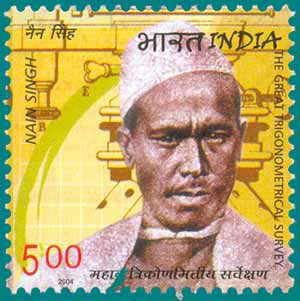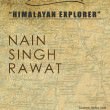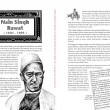Nain Singh Rawat – Explorer of the Himalayas
Pandit Nain Singh Rawat was one of the first pundits who explored the Himalayas for the British. Born in 1830 in Milan, Pithoragarh, Nain Singh Rawat was called a Pandit on account of his profession of teaching.
He is known for his extensive and arduous travels and survey work in Tibet and southern parts of Russia. He wrote his memoirs on the basis of his extensive travels. For his valuable contributions to discoveries he was awarded the prestigious Companion of Indian Empire. Pundit Nain Singh Rawat received a Royal Geographical Society gold medal in 1876. He mapped the trade route through Nepal to Tibet, determined for the first time the location and altitude of Lhasa, and mapped a large section of the Tsangpo, the major Tibetan river.
In 1865 Nain Singh left Dehradun and head towards Nepal with his cousin Mani Singh. From there Mani returned to India by way of western Tibet, but Nain Singh went on to Tashilhunpo, where he met the Panchen Lama. He also met Dalai Lama at Lhasa. Nain Singh returned to India by way of Mansarovar Lake in western Tibet.
By measuring the boiling temperature of water, he calculated the altitude of Lhasa to be 3240 m above sea level –astonishing precision, when you consider that we today believe it to be 3540m. From the angular altitude of stars, he then calculated the latitude of Lhasa. In 1874, Nain Singh went on his third and last excursion into Tibet, to survey the route from Leh to Lhasa.
He continued for a few years to train other Indians in the art of surveying (and spying), and did a highly commended job of it, too. On his retirement, the Indian Government honored him with the grant of a village, and 1000 rupees in revenue. He passed away in 1895 while visiting his Jagir, a village in the Indian Terai (plains) granted to him by the British in 1877.
After seeing his extraordinary feats of exploration, Colonel Henry Yule commented that “his explorations have added a larger amount of important knowledge to the map of Asia than any other living man”
On June 27, 2004, an Indian postage stamp featuring Nain Singh was issued commemorating his role in the Great Trigonometrical Survey (GST).

Stamp of Nain Singh Rawat (pic src: http://indiapicks.com)
Career Information:
- Schlagintweit Brothers’ Expedition (1855-1857): At the age of 25, Nain Singh was first recruited by the German geographers, Schlagintweit Brothers. Baron Humboldt had sent these German scientists to the office of Survey of India, which reluctantly allowed them to proceed for the survey. Adolf and Robert Schlagintweit met old Deb Singh Rawat in the Johar valley, who advised them to recruit three members of his family for their expedition – Man Singh Rawat (Mani Compasi), Dolpa Pangtey and Nain Singh Rawat. Nain Singh’s first exploration journey was with these Germans from 1855 to 1857. During this mission, he travelled to Mansarovar and Rakastal lakes in Tibet, then further to Gartok and Ladakh.
- Education Department (1858-1863): After the expedition with the Schlagintweit Brothers, Nain Singh joined the Education Department as a teacher at the Government Vernacular School in his village Milam in 1858. Later, he was appointed as the headmaster of this school, where he served till early 1863. During those days, people commonly used to address to the teachers with the name “Pundit” (Knowledgeable Person). That’s where the famous title or prefix of “Pundit” came!
- Great Trigonometrical Survey (1863-1875): In 1862-63, Education Officer Edmund Smyth was in correspondence with Captain Montgomery to recruit some trustworthy natives as explorers for the Great Trigonometrical Survey. On the recommendation of Edmund Smyth, Nain Singh and Mani Singh Rawat were selected for this expedition at a starting salary of rupees twenty a month. Nain Singh worked in the active service of the Great Trigonometrical Survey from 1863-1875. Nain Singh was given code names “Chief Pundit” or “No. 1” for this clandestine expedition by the survey officials. He not only worked as a surveyor in the GST, but also trained many surveyors and explorers for other expeditions.
Survey Missions / Expeditions of Nain Singh Rawat:
- 1865-66 : Kathmandu – Lhasa – Mansarovar Lake.
- 1867 : Origin of Sutlej and Indus rivers, and Thok Jalung (Tibet).
- 1870 : Douglas Forsyth’s First Yarkand – Kashgar Mission.
- 1873 : Douglas Forsyth’s Second Yarkand – Kashgar Mission.
- 1874-75 : Leh – Lhasa – Tawang (Assam).
Awards and Recognitions
- In 1868, Nain Singh was presented with an inscribed gold chronometer/watch by the Royal Geographic Society (RGS), London.
- In 1876, Nain Singh’s achievements were announced in the “Geographical Magzine”.
- In 1877, Nain Singh was awarded with the “Victoria / Patron’s Gold Medal” by the Royal Geographic Society (RGS), London.
- In 1877, Nain Singh was presented with an inscribed gold chronometer/watch by the Society of Geographers of Paris.
- In 1877, the British government awarded him with the title of “Companion of the Indian Empire” (C.I.E.)!
- In 1877, the British government honoured him with a grant of a village in Rohilkhand (Bareilly) as Jagir, and 1000 rupees in revenue.
- On 27th June 2004, an Indian postage stamp featuring Nain Singh was issued commemorating his role in the Great Trigonometrical Survey by the Indian government, after about 139 years since his achievement!
Literature By Nain Singh Rawat
- Akshansh Darpan (Mirror of Latitudes): Nain Singh has put all his scientific and technical information about his experiments and the experiences of the explorations during the Great Trigonometrical Survey (1865-75) in writing in the form of this book. It worked as a good manual/guide for the later generations of explorers.
- Itihaas Rawat Kaum (History of Rawats) : This book is about the history of the Rawats, a sub-group of the larger Shauka community of Johar valley in Pithoragarh (Uttarakhand).
- Nain Singh’s Diaries / Reports : These are the unpublished works of Nain Singh in the form of Diaries and Reports. The original manuscript of these works is missing, but some historians have tried to publish them using the available sources.
There are several forms of media in which information about Pundit Nain Singh Rawat and his extraordinary achievements has been published / illustrated.
(A) Literature
- Report of a Route-Survey made by Pundit & Others – T. G. Montgomery, The Journal of the Royal Geographic Society, Vol. 38 (1868).
- Report of the Trans-Himalayan Explorations during 1867 – T. G. Montgomery, The Journal of the Royal Geographic Society, Vol. 39 (1869).
- Account of the Pundit’s Journey in Great Tibet – Capt. H. Trotter, The Journal of the Royal Geographic Society, Vol. 47 (1877).
- A Memoir on The Indian Surveys, 2nd Ed. – Clements R. Markham, W H Allen & Co., London (1878).
- A Memoir on The Indian Surveys (1875-90) – Charles E. D. Black, London (1891).
- The Heartland of Asia – Nathale Ettinger, Aldus Books, London (1971).
- Indian Explorers of the 19th Century – Indra Singh Rawat (1973).
- The Rand McNally World Atlas of Exploration – Rand McNally & Co., New York (1975).
- To the Farthest Ends of the Earth : The History of the Royal Geographical Society (1830-1980) – Ian Cameron, Macdonald, London (1980).
- Johar Ka Itihaas (History of Johar) – Babu Ram Singh Pangtey (1980).
- The Mapmakers – J. N. Wilford, Knopf, New York (1981).
- Trespassers on the Roof of the World : The Race for Lhasa – Peter Hopkirk, Oxford University Press (1982).
- The Pundits : British Exploration of Tibet and Central Asia – Derek J. Waller, University Press of Kentucky (1990).
- Accidental Explorers : Surprises and Side Trips in the History of Discovery – Rebecca Stefoff, Oxford University Press, New York/Oxford (1992).
- Pundit Nain Singh – Dr. Ram Singh.
- Madhya Himalaya Ki Bhotia Janjaati (Bhotia Tribe of The Central Himalayas) – Dr. Sher Singh Pangtey (1992).
- Asia Ki Peeth Par : Pundit Nain Singh Rawat – Uma Bhatt & Shekhar Pathak, PAHAR, Nainital (2006).
(B) Television / Documentary
- Himalaya Darshan – Doordarshan (Prasar Bharti), India (1990-94).
- Discovery Channel / National Geographic Channel / The History Channel.
-

-
Nain Singh Rawat Minimal Poster by Sandeep Bisht
-

-
Article on Pundit Brothers (Nain Singh & Kishan Singh) ‘Sunday Nayi Duniya’ – 19th July 2009 (Src: legends-of-johar.blogspot.in)
-

-
Nain Singh Rawat – Book Cover of Asia ki Pheet Par by Shekhar Patak (src: Uttarakhand.org)
-

-
Nain Singh’s Last Journey Route (1874-75) [Leh – Lhasa – Tawang] (src: legends-of-johar.blogspot.in)
-

-
Article on Nain Singh Rawat ‘INSA’ – Platinum Jubilee Edition (src: legends-of-johar.blogspot.in)
:
IAS.ac.in,
Wikipedia,
Legends of Johar

Very inspiring
written very well..
Sir can u provide me the info regarding the book “Asia Ki Peeth Par”…so that I would easily purchase it.
Thanks for the account of Nain Singh’s life and explorations. It’s an inspiring story.